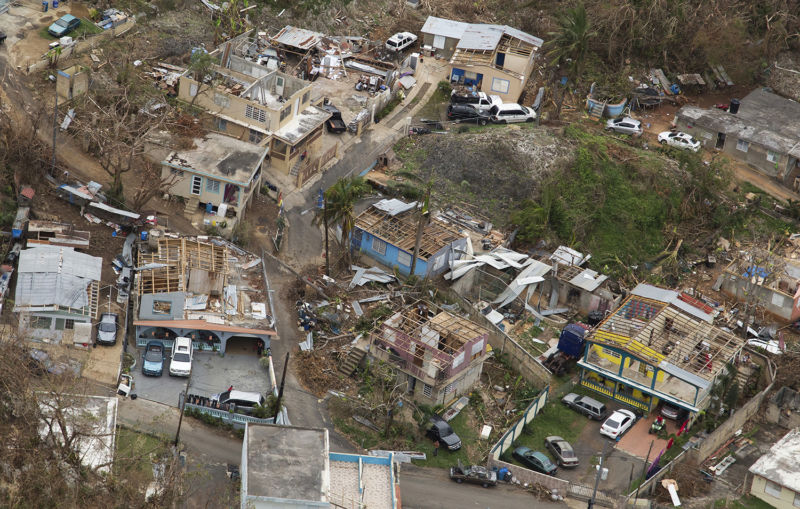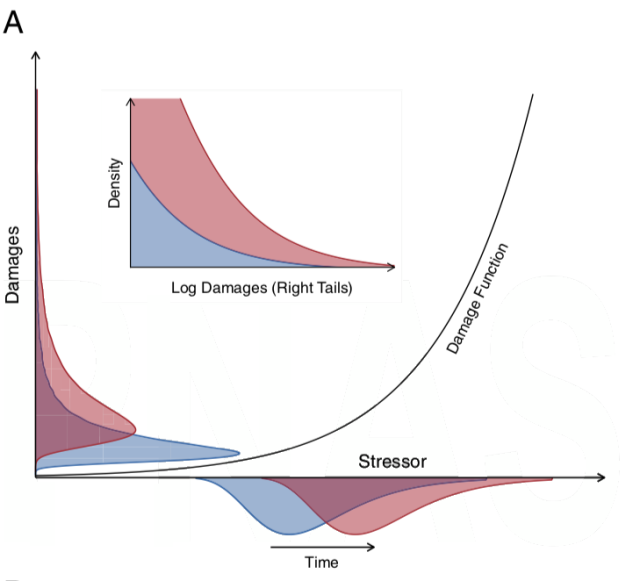
With the warming local weather, we should always count on a change in weather-related disasters. Fewer chilly snaps and stronger warmth waves are the apparent points. However we must also see extra intense storms, as a hotter ambiance can maintain extra water vapor, whereas droughts might intensify in areas the place rain was already sparse as the warmth bakes water out of the soil.
All that means the prices of climate disasters will likely be totally different—however not essentially higher or worse. Researchers who've tried to check the subject have provide you with very combined outcomes: some present an upward development in the price of pure disasters, whereas others fiercely dispute these analyses. Now, a brand new research suggests a attainable motive for this: whereas the common injury brought on by disasters is staying comparatively steady, probably the most excessive occasions are growing quickly. However in a small little bit of comfort, the human prices could also be dropping.
A confused literature
It might sound that analyzing the price of climate disasters can be easy: determine the disasters, complete the price, and see if there is a development over time within the warming world. However the actuality is extra advanced. One complication is clear: offsetting results. Warmth waves are going up in a warming world, however chilly snaps are dropping. If these modifications have offsetting prices, you can see no impact even because the dynamics shift.
Geography may also common out actual modifications. For instance, the Western US is getting drier, elevating the danger of drought, whereas the northeastern a part of the nation is seeing extra intense rainfall. If you happen to take a look at the nation as a complete, these results could make it seem as if there have been no change regardless of each areas having extra climate-related issues.
One other complicating issue is that excessive climate is, by its nature, uncommon and erratic. For instance, the US lately went by a multi-year interval the place no hurricanes made landfall, which might have skewed any catastrophe traits based mostly on current information. Lastly, there's the truth that we alter our personal habits, in some circumstances in response to disasters. That might imply extra (or extra priceless) property within the path of potential climate disasters. However it might additionally imply that hurricanes alter constructing codes, whereas wildfires change how we deal with brush clearance and even whether or not we offer electrical energy. It is solely attainable that having one catastrophe might cut back the injury by an equal one which struck afterwards, provided that we have modified in response to the primary.
All of this has left the catastrophe literature a little bit of a multitude. Some papers discover traits, others do not, and but others discover that there is merely not sufficient information to supply a sign that rises above the statistical noise.
Pondering large
The researchers behind the brand new work took a barely totally different method to doing the evaluation, one which's best to know utilizing a diagram from the paper.

The work exams whether or not damages behave just like the upward curve of the black line in the principle graph. If that's the case, then as impression of a stressor—rising temperatures, proven in purple on the backside of the graph—will increase, the potential for injury rises in a non-linear method. If so, we might count on to see two issues. As proven to the left of the graph, the blue curve of current damages would shift upward, making a purple bulge that also encompasses many of the regular vary of occasions however has extra of the high-damage occasions. As proven within the inset, you'd additionally begin to see damages of a magnitude that merely hadn't occurred beforehand.
On this view, the common damages would solely change slowly, since prior and current likelihood curves on the left of the graph overlap a lot. However you'd see extra of the most-damaging occasions and some that had by no means been seen earlier than.
To look into this example, the researchers developed a mannequin that takes into consideration the price of disasters and the frequency with which disasters of a given value happen. They then examined whether or not these numbers have been altering over time. For instance, you can determine damages from the most expensive disasters from the 1960s after which see if there have been extra disasters on this value vary within the 2000s. Or you can additionally see if the variety of disasters that have been much more costly went up over time.
Clearly, the researchers needed to management for a wide range of components, like inhabitants measurement and GDP of the areas affected by disasters, as wealthier societies have extra worth in danger. However in addition they examined whether or not the local weather zone—tropical vs. temperate vs. polar—made a distinction.
The excellent news
What the researchers discovered matched up effectively with their predictions. Whereas there was little change within the median value of a catastrophe, the frequency of the most costly disasters grew dramatically over time. Within the authors' phrasing, the curve that describes catastrophe frequency grew a "fats tail" among the many most costly disasters. "Such outcomes point out that the financial impacts of pure disasters are certainly rising, however under no circumstances scales," they argue.
However there's some excellent news right here. The authors repeated the evaluation utilizing human deaths because the measure, somewhat than financial impression, and located the other development: the human value has gone down, primarily because of a dramatic lower within the deaths because of extreme droughts. There was, nevertheless, a gentle improve within the variety of individuals killed by excessive warmth occasions, so the researchers warning that this might wipe out the excellent news if temperature rises proceed unabated.
There is no motive to suppose that these outcomes will put an finish to arguments about whether or not local weather change is growing the danger or value of pure disasters. The subject is much too sophisticated, and any evaluation goes to be restricted by the questions it asks and its selections concerning how these are requested. And people limitations undoubtedly apply to this research. There merely aren't many pure disasters which can be on the excessive finish when it comes to value, so to get any form of statistical significance, the researchers needed to lump collectively droughts, warmth waves, and different occasions that are not very intently associated.
However the research is effective in that it suggests quite a lot of attention-grabbing questions. Expensive disasters within the tropics did not improve as a lot as they did in temperate areas—why's that? What's modified that is triggered droughts to be a lot much less lethal? Getting solutions to questions like these might doubtlessly assist us plan for the steadily rising temperatures we're anticipated to see this century.
PNAS, 2019. DOI: 10.1073/pnas.1907826116 (About DOIs).
